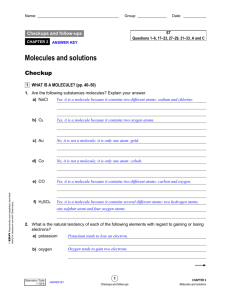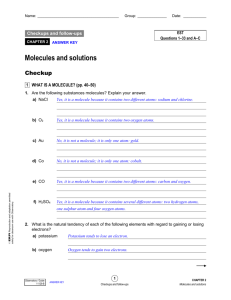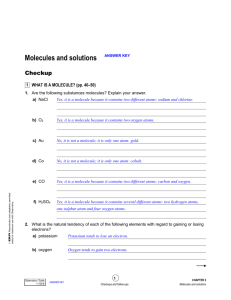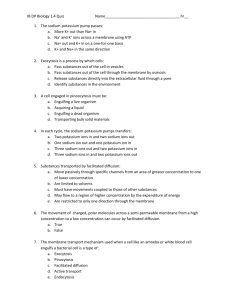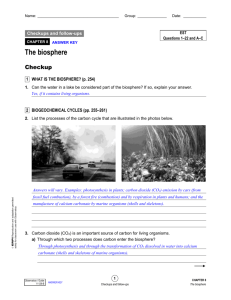Molecules and solutions
advertisement
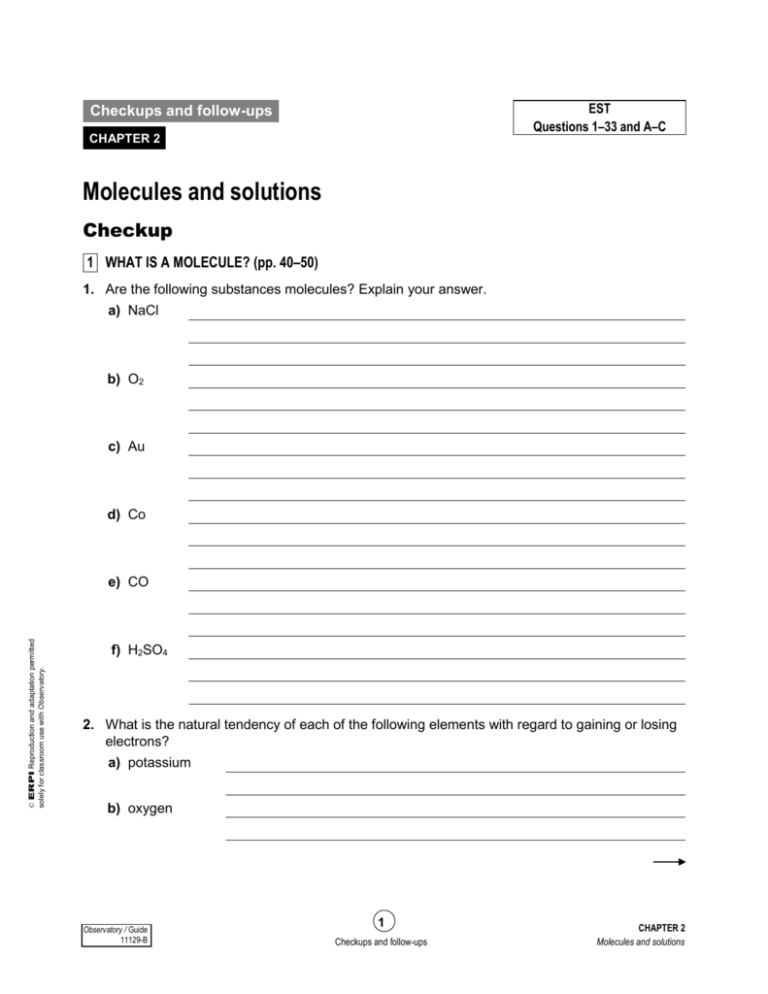
EST Questions 1–33 and A–C Checkups and follow-ups CHAPTER 2 Molecules and solutions Checkup 1 WHAT IS A MOLECULE? (pp. 40–50) 1. Are the following substances molecules? Explain your answer. a) NaCl b) O2 c) Au d) Co © ERPI Reproduction and adaptation permitted solely for classroom use with Observatory. e) CO f) H2SO4 2. What is the natural tendency of each of the following elements with regard to gaining or losing electrons? a) potassium b) oxygen Observatory / Guide 11129-B 1 Checkups and follow-ups CHAPTER 2 Molecules and solutions c) aluminum d) krypton 3. Metals give up electrons. Consequently, do they tend to form positive or negative ions? 4. Calculate the sum of the charges for each of the following electron transfers, and indicate the net charge of the resulting ion. a) A calcium atom loses two electrons. c) An iodine atom gains one electron. b) A nitrogen atom gains three electrons. d) An aluminum atom loses three electrons. 5. Do the models below represent atoms or ions? Explain your answers. a) b) 6. Iron has the ability to form one of two ions: Fe2+ or Fe3+. How many protons and electrons does each of these ions contain? 7. Various soaps and detergents contain phosphates that contaminate the water in lakes and rivers. For this reason, many environmental groups encourage consumers to use phosphatefree cleansers. a) Is a phosphate an atom, a molecule or an ion? b) What is its chemical formula? 8. Do the following molecules contain a polyatomic ion? If so, write its chemical formula and its name according to the rules of nomenclature. a) NaOH b) C6H22O11 c) MgSO4 d) H3PO4 9. Which of the following substances contain at last one ionic bond? HCl, NaOH, CO2, KBr, CaO, AlCl3, NH3 10. Draw a Lewis structure for each of the following molecules to show how their ionic bonds are formed. © ERPI Reproduction and adaptation permitted solely for classroom use with Observatory. a) LiF b) CaBr2 c) Li3N Observatory / Guide 11129-B 3 Checkups and follow-ups CHAPTER 2 Molecules and solutions d) MgO 11. What is the charge of each of the ions in the following molecules? a) NaBr c) Li2S b) CaO d) AlF3 12. Which of the following substances contain at least one covalent bond? CH3COOH, CS2, CoCl2, Fe2O3, H2O, CH4, AgCl 13. Draw a Lewis structure for each of the following molecules to show how their covalent bonds are formed. a) Cl2 c) CO2 b) CBr4 d) HF 14. What does the subscript 2 mean in the molecule MgCl2? 15. Write the chemical formula of the molecule resulting from the union of each of the following pairs of substances. a) potassium and sulphur b) chlorine and copper c) chromium and fluorine d) the ions Mg2+ and SO42− 16. Apply the rules of nomenclature to name the following substances. a) NaBr b) PCl5 c) SiCl4 d) K3N © ERPI Reproduction and adaptation permitted solely for classroom use with Observatory. e) Al2O3 Observatory / Guide 11129-B 5 Checkups and follow-ups CHAPTER 2 Molecules and solutions
